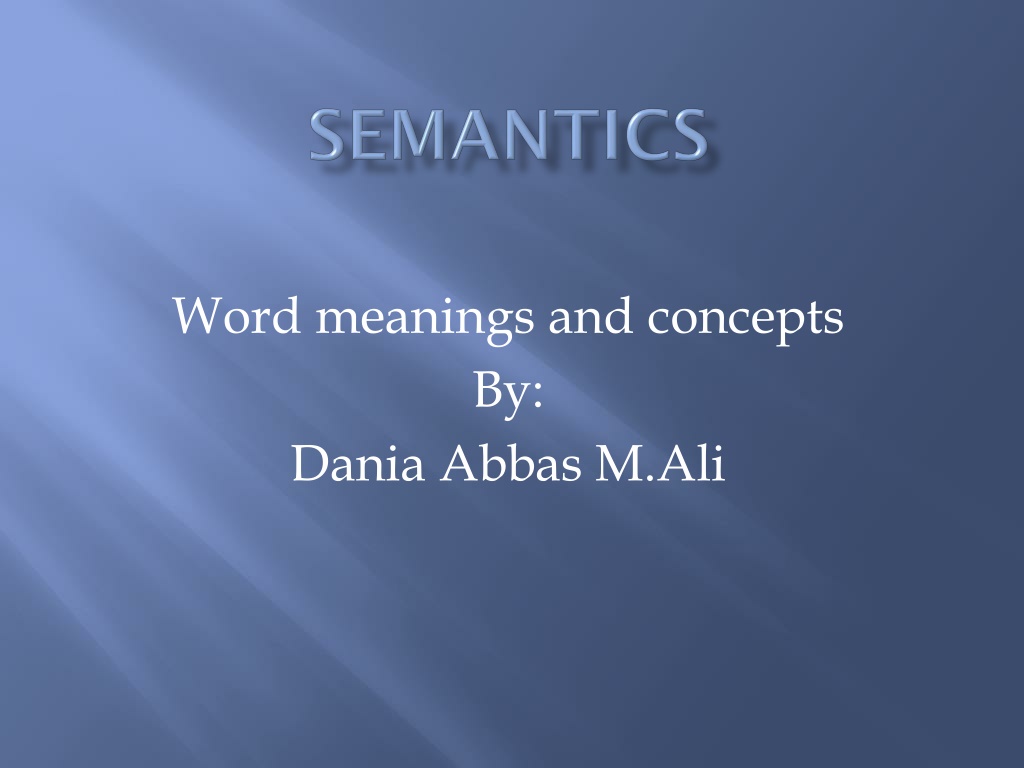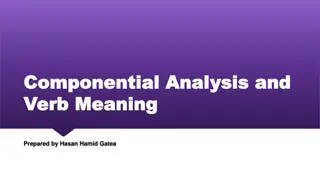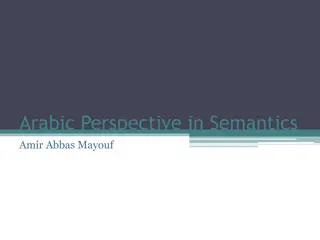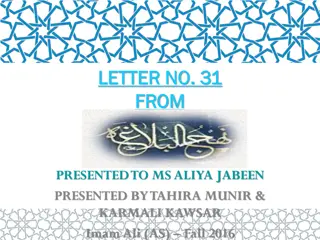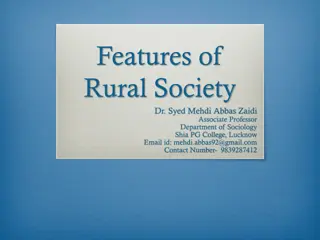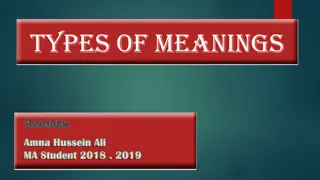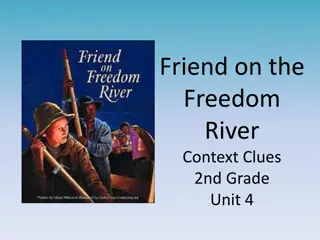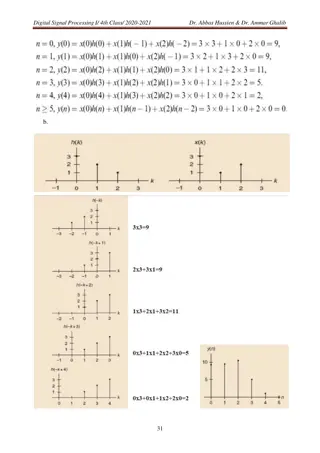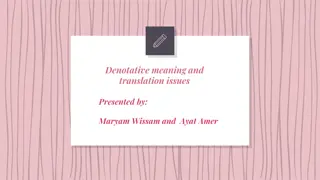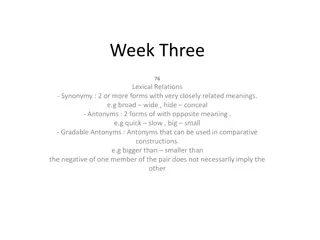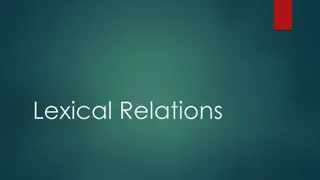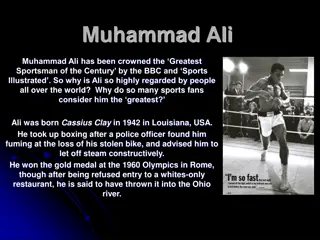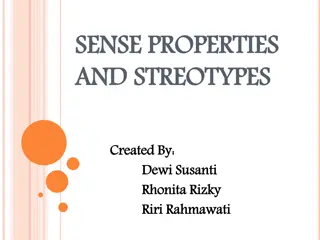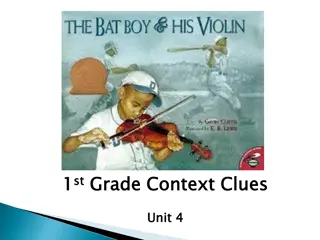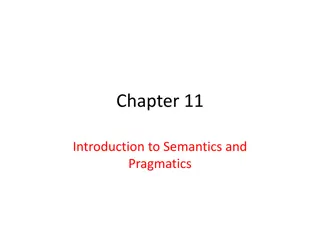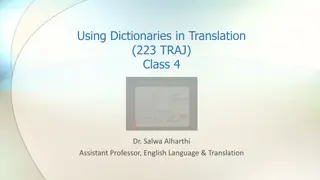Understanding Word Meanings and Concepts by Dania Abbas M. Ali
Explore the interconnected world of word meanings and concepts as articulated by Dania Abbas M. Ali. Learn how our stored knowledge organizes experiences into categories, enabling recognition and recollection. Concepts form complex networks, linking various ideas together. The relationship between lexical items and concepts is highlighted, showcasing the activation and linkages within our cognitive processes.
Download Presentation

Please find below an Image/Link to download the presentation.
The content on the website is provided AS IS for your information and personal use only. It may not be sold, licensed, or shared on other websites without obtaining consent from the author. Download presentation by click this link. If you encounter any issues during the download, it is possible that the publisher has removed the file from their server.
E N D
Presentation Transcript
Word meanings and concepts By: Dania Abbas M.Ali
They are organized bundles of stored knowledge representing an articulation of events, entities, situations, and so on in our experience. It is only because we can put elements of experience into categories, that we can recognize them as having happened before, and we can remember our previous reactions to their occurrence.
Concepts are linked together in a complex multi-dimensional network. These links correspond to concepts of a more schematic kind than the concepts which they serve to connect, which are typically richer and more complex.
Each full lexical item directly activates a concept and indirectly activates linked concepts according to the strength of the link. There is no direct link between the word horse and the concept ANIMAL: the word horse has a direct link only with the concept HORSE
One-to-one: in this arrangement, a word gives access to a single concept syzygy syzygy
one-to-many: : financial institution bank margin of river
many-to-one die kick the bucket DIE pass away
Many to many: it is a combination of the previous two types. Word- specific properties: words or expressions that are not identical in meaning but since they all map the same concept, means that the difference between them must be a property of the words themselves not of the concept.
The meaning of a word consists of word-specific properties plus the properties of the associated concept. we can distinguish words like die, horse, and cry, which activate their associated concepts (DIE, HORSE, and CRY) in a neutral way, from those like kick the bucket, pass away, nag, steed and blubber.
The expressive possibilities of language are infinite. Since the brain is a finite physical object, it cannot store an infinite number of linguistic forms mapped on to an infinite number of concepts. Three independent levels of structure : Phonological, syntactic, and conceptual.
Conceptual structure could in principle be richer than expressible linguistic meanings, but it cannot be less rich. Jackendoff calls this the expressive constraint. (He also has a grammatical constraint, which amounts to a bias in favour of conceptual structures that can be put into transparent correspondence with surface syntactic structures and against 'deep structures' of a radically different form to the corresponding surface forms.)
there is only one level; that is to say, syntactic structures map directly on to conceptual structures. The basis for this view is that there is no work for a distinct semantic level to do: everything needed to motivate grammatical structure is present in conceptual structure.
1. they classify experience. 2. give access to knowledge concerning entities which fall into them. The classical approach defines a category in terms of a set of necessary and sufficient criteria. (x is a category of GIRL) X is human X is female X is young
If any of these criteria are not satisfied, then X is not a girl (i.e. the criteria are individually necessary); if all the criteria are satisfied, then X is a girl (i.e. the criteria are jointly sufficient).
Lack of plausible analyses There are many everyday words whose meanings cannot be captured by means of a set of necessary and sufficient features.(game) 1. involves winning and losing: there are many games which do not involve winning and losing : party games or children's games. 2. involves more than one person. 3. has arbitrary rules. 4.done purely for enjoyment.
A fuzzy statement is a statement which is true to some extent and that extent can often be represented by a scaled value. The boundaries of natural categories are fuzzy and contextually flexible.
the classical conception of categories goes, everything that satisfies the criteria has the same status, that is to say, something is either in the category, or not in it, and that is all there is to say about the matter. some members are felt to be 'better' examples of the category than others. For instance, an apple is a better example of a fruit than is a date, or an olive.
The natural conceptual categories are structured around the 'best' examples, or prototypes of the categories, and that other items are assimilated to a category according to whether they sufficiently resemble the prototype or not. .
Subjects are asked to give a numerical value to their estimate of how good an example something is of a given category. 1: very good example 2: good example 3: fairly good example 4: moderately good example 5: fairly poor example 6: bad example 7: very bad example/not an example at all
POTATO, CARROT I TURNIP, CABBAGE 2 CELERY, BEETROOT 3 AUBERGINE, COURGETTE 4 PARSLEY, BASIL 5 RHUBARB 6 LEMON 7
there is abundant evidence that prototypicality, aspects of correlates strongly with important cognitive behavior. The principal prototype effects are as follows: Order of mention When subjects are asked to list the members of a category, and especially if they are put under time pressure, the order of listing correlates with GOE ratings, with the prototypical member showing a strong tendency to appear early in the list.
Overall frequency The overall frequency of mention in such lists also correlates with GOE score. Order of acquisition Prototypical members of categories tend to be acquired first, and order of acquisition correlates with GOE rating. Vocabulary learning Children at later stages of language acquisition, when vocabulary enlargement can be greatly
influenced by explicit teaching, learn new words more readily if they are provided with definitions that focus on prototypical instantiations than if they are given an abstract definition that more accurately reflects the total range of the word's meaning. Speed of verification In psycholinguistic experiments in which subjects are required to respond as quickly as they can to a categorization task, subjects produce faster responses if the tasks involve a prototypical member. .
Priming It is a well-established experimental fact that if a word is preceded by a semantically related word, response to it will be speeded up, for instance, a Yes response to DOCTOR will be faster if NURSE has been just previously presented .
A purely linguistic characterization of categories with a prototypic organization is that they show intuitive unity, but are definitionally polyvalent. For instance, the semantic field covered by the term game can be quite well described by means of a restricted set of definitions, but no satisfactory unitary definition exists . .
Only the prototype has 100 per cent membership of a category, the degree of membership of other items being dependent on their degree of resemblance to the prototype. There is no fixed limit on how far something can depart from the prototype and still be assimilated to the class, if the categorizer is perceptive or clever enough to find some point of resemblance to typical instances. There is no fixed limit on how far something can depart from the prototype and still be assimilated to the class, if the categorizer is perceptive or clever enough to find some point of resemblance to typical instances.
there was some sort of portrait of the prototypical member, against which the similarity of other items could be computed and their status in the category determined. Many prototype theorists speak only of 'prototype effects', and remain uncommitted on the subject of the form of mental representations. categories with a prototype structure are represented by a set of features. .
these do not constitute a set of necessary and sufficient criteria, except perhaps for the prototype itself. Some features will have a greater effect on determining centrality in the category than others. The general idea can be illustrated using the category VEHICLE.
(a) vehiclecarhatchback. (b) fruit apple Granny Smith. (c) living thing creature animal cat Manx cat. (d) object implement cutlery spoon teaspoon. basic or generic level of specificity (i) The most inclusive level at which there are characteristic patterns of behavioural interaction: imagine being asked to mime how one would behave with an animal. This is rather difficult without knowing whether the animal in question is a crocodile or a hamster.
(ii) clear visual image can be formed: try to visualize an item of cutlery or a vehicle, a fork or a lorry, however, are easy to visualize. (iii) Used for neutral, everyday reference, suppose A and B are sitting at home; A hears a noise outside and says What's that? B looks out of the window and sees an alsatian in the garden. normally (b) will be chosen: (a) It's an animal. (b) It's a dog. (c) It's an alsatian.
(iv) The basic level is the level at which the best categories can be created. (a) distinctness from neighbouring categories; (b) internal homogeneity; (c) differential informativeness categories which are more inclusive than the basic level have less internal homogeneity, while narrower categories show less distinctness from neighbouring categories
(v) Names of basic level categories tend to be morphologically simple, take the case of spoon, which is a basic-level term; all the more specific categories have more complex names: teaspoon, tablespoon, soup spoon, coffee spoon, etc.
Category boundaries and boundary effects the 'standard' prototype view is that no category boundary is recognized. A category without a boundary is virtually useless: a primary function of a category is to discriminate between things which are in it and things which are not in it. The classical view of categories, with necessary and sufficient features, set a boundary but allowed no internal structure.
Degrees of membership only the prototype of a category has 100 per cent membership of the category, other items having a degree of membership dependent on their resemblance to the prototype. Once boundaries are assigned, then an item must be a full member of the category, not a member at all, or a borderline example. Even a non-central member of a category is a full member.
degree of membership applies only to borderline cases. BICYCLE and SKATEBOARD to be borderline instances of the category VEHICLE. I myself, for instance, would judge BICYCLE to have a higher degree of membership than SKATEBOARD
Compound categories The categories which result from the combination of two (or more) basic categories are often regarded as presenting particular problems for prototype theory. It might be reasonably demanded of a prototype approach that the prototype of a compound category should be predictable from the representations of the component categories.
Context sensitivity Typically, GOE ratings are assigned to putative members of named categories out of context. But it is intuitively obvious that judgements of the 'best examples of, say, the category [CAR] are going to depend on whether one has in mind a racing context, a context of town use, or long- distance travel
NATURAL CONCEPTUAL CATEGORY First, it seems clear that a good category will distinguish clearly between things that are in it and things that are not in it; in other words, it will have a relatively well-defined boundary. Second, bearing in mind that a major function of conceptual categories is to provide headings under which information/knowledge can be economically stored, it is reasonable to expect a good category to be richly informative, in the sense that knowing that some entity belongs to a particular category
gives access to a substantial body of knowledge about the entity. categories are not built to the same pattern. variation in the relative importance of the internal structure and the boundary. An extreme case would be a category with boundaries but no internal structure at all. This would be the case for a category defined purely by means of a list of members The balance of salience between boundary and internal structurecan vary. For instance, GAME has very fuzzy boundaries, but a rich internal structure, whereas ODD NUMBERhas clear boundaries, but a relativelyweak internal structure
The meaning of, say a noun, is a combination of its denotation and a conceptual element, two basic questions about the conceptual element are: 1 What form can we assign to concepts? 2 How do children acquire them, along with their linguistic labels? Lexicalized concepts are the ones that correspond to single word.
Some concepts are described by phrases: On the shopping channel, I saw a tool for compacting dead leaves into garden statuary Unity describing something that for a while was given the two-word label microwave oven, but is now usually called just a microwave. Ex: We re designing a device for cooking food by microwaves.
New concepts are invented and new words or new senses of old words given to them. Children acquiring concepts we have to recognize that their concepts may differ from the concepts of adults. Children may operate with concepts that are quite different, underextending concepts when for a child dog can only be used for their pet, not the one next door;
overextending concepts, where a child uses daddy for every male adult, or cat for cats, rabbits and other pets.
If we have a concept like woman, it must contain the information necessary to decide when something in the world is a woman or not. If something must have them to be a woman, then they can be called necessary conditions. In addition, if we can find the right set enough to define a woman, then they can be called sufficient conditions, we have identified the right amount of information for the concept.
Ignorance: when speakers often use words to refer knowing very little, and sometimes nothing, about the identifying characteristics of the referent. Definition : that a word is referring to a concept composed of a set of necessary and sufficient conditions, or what amounts to the same thing.
A model of concepts which views them as structured so that there are central or typical members of a category, such as bird or furniture, but then a shading off into less typical or peripheral members. So chair is a more central member of the category furniture than lamp, for example.
Speakers tend to agree more readily on typical members than on less typical members; they come to mind more quickly. borderline uncertainty: an item in the world might bear some resemblance to two different prototypes. We don t know whether a whale is a mammal or fish. whales resembl eprototypical fish in some characteristic features: they live underwater in the oceans, have fins, etc.
some researchers have argued that the central prototype is an abstraction. This abstraction might be a set of characteristic features, to which we compare real items for discussion. Other researchers have proposed that we organize our categories by exemplars, memories of actual sparrows, pigeons and hawks, and we compute the likelihood of something we meet being a bird on the basis of comparison with these memories of real birds
